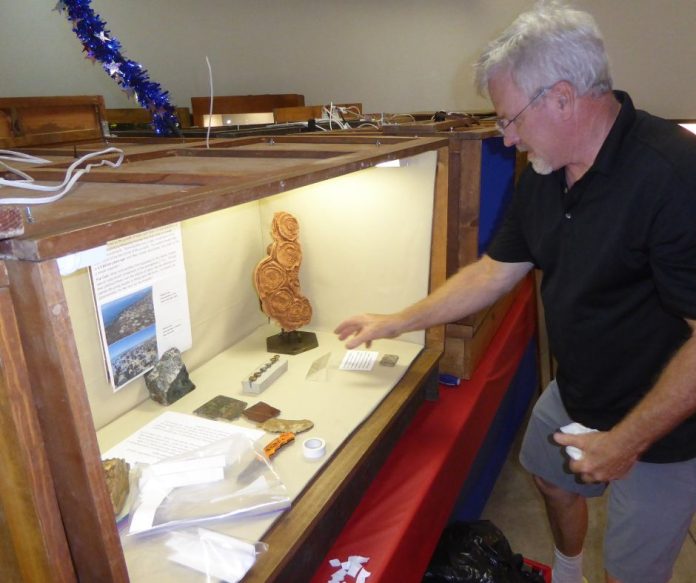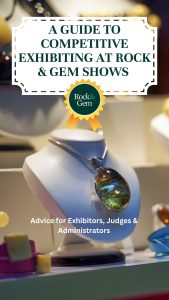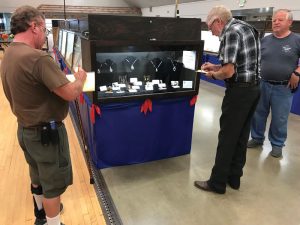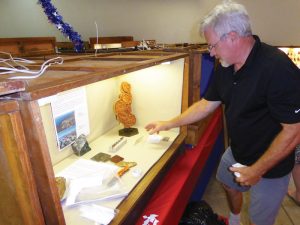
Rock and gem shows through venues like club shows, county fairs, trade shows and Federation shows, offer opportunities for competitive exhibiting to earn awards. Since 1995, I’ve been involved in competitive exhibiting from three perspectives: administering, judging, and exhibiting. Here are my suggestions for best practices.

Suggestions For Administrators
The administration is where it begins—and where it ends when a show is administered poorly.
Promote, Recruit & Prepare
At annual competitions, many administrators are passive, letting exhibitors find them rather than proactively recruiting. With annual shows, maintain a database, then pursue the best exhibitors via email, phone, and mail applications with personalized letters of invitation. The best competitive shows are those with the best exhibitors. Also, be prepared with an organized check-in with paperwork and exhibit floor layouts for a smooth front door process.
Select Open-Minded Judges
I’ve seen instances where judges have never competed. As they say, don’t judge people until walking a mile in their shoes. That said, simply getting judges is difficult. It’s best though to subject paid judges to the same scrutiny as any job. Solicit candidates. Conduct a selection process. Avoid last-minute desperation for any warm body.
Many judges—particularly for lapidary/ jewelry arts—approach judging from a rigid perspective based on how they learned the craft. How different might it be if we selected judges delighted to see a new way to approach art? We’re told exhibitors should not take criticism personally and should view judges’ comments as a learning experience. But can’t it go both ways? Can’t we have judged as eager to learn as to pass judgment?
Select Judges Who Listen
Make sure judges follow advice. At one show judges were told, “Don’t mark down things exhibitors have no control over, like a fly in the case. Flies happen.” One judge’s first comment? “One point off. Dead fly in the corner.” If judges can’t listen, administrators should reverse a deduction. If a judge proves problematic, discuss it. If the judge comes back next year and issues persist, move on.
Be Fair & Impartial and Don’t Change Rules Mid-Steam
Don’t show a knee-jerk reaction to favor judges over exhibitors when complaints arise. Objectively listen and, if necessary, have an exhibit re-examined by the judge or by a new set of eyes. Don’t automatically assume “sour grapes” from disappointed exhibitors. Most exhibitors study the rules more thoroughly than some judges. Respect both sides.
I’ve been in shows in which rules changed. In one, dollar awards promised for exhibits were rescinded midstream because of “rules” that had not been clearly posted and went counter to previously established practice. Want to discourage future exhibitors? Pull rugs out from current exhibitors!
What’s Wrong with a Tie?
Most competitions insist on one winner. This leads to nitpicking. But if two exhibits are equally excellent, what’s wrong with awarding two first-place trophies? If you see excellence, award excellence!
I’m advocating the “Danish System.” Exhibitors don’t compete against one another but attempt to live up to a uniform set of standards. This allows for more awards among competitors by recognizing that two subjectively different exhibits in the same Class may achieve equal excellence.
Create a Pleasant Work Environment
At one event, the administrator constantly berated one volunteer and complained incessantly. Does this entice volunteers to return? Make it pleasant. If you’re not having fun—and it shows—neither will volunteers.
Rock and Gem Shows – Takeaways for Administrators• Promote, recruit, and prepare. • Select open-minded judges; be fair to all parties. • Don’t change the rules midstream. • Always award excellence. • Create a pleasant work environment. |

Suggestions For Judges
Judges hold different philosophies, and that’s all right. But I reject two out of hand.
“Hang ’em High” Judges. Some allow nothing short of perfection even if perfection is an abstract ideal impossible to meet. Like hungry vultures, they pick a fine display down to the bones.
“Hurt No One” Judges. Some have a kind heart and provide only positive comments even while deducting points. This does a disservice. What hurts worse? Not scoring in the top level or not being told why and how to improve?
Make Judging a Learning Experience.
Judges should never submit score sheets until each point deducted is explained. Here are a few suggestions.
1. Make it educational, not punitive. Work to improve the quality of displays not browbeat exhibitors. Offer encouraging advice so exhibitors will listen and try again. As past AFMS President Dee Holland always said, exchange the word “judge” with “teacher.”
2. Don’t deduct points without providing a reasonable rationale. I was paired to judge a person who nitpicked a case to death. He even said one crystal was excellent but could’ve been better displayed if rotated 30 degrees. “Showmanship: 2 points off !” At least he provided a comment. But was it reasonable?
3. Avoid judgmental language. Don’t use “bad,” “poorly executed,” or other offensive terms. I entered thumbnail minerals in a competition and was told one was “tiny, tiny, tiny.” One “tiny” sufficed and even if it was, it fell within specified parameters for thumbnails. Shouldn’t it have been judged on quality?
4. Don’t question without a counter-reference. One exhibit noted “Ocean Jasper is actually orbicular agate” and provided a reference. Judges disagreed. They deducted points without providing a counter-reference. Exhibitors conduct considerable research, so the onus is on judges to provide a counter-reference— or defer to exhibitors.
“Moderation in All Things, Especially Moderation”
Some wish for shows where the highest standards and deepest pockets prevail. Such is the “high-end” international shows. Others may want to reward everyone, which dilutes any standards.
At the amateur hobby level, the goal should be to reward honest efforts yielding solid results. Everyone shouldn’t be given a participation trophy, but we shouldn’t critique one crystal that may have been better displayed if rotated 30 degrees.
The Importance of Having Fun
My final plea to judges? Keep an open mind! Have fun! If not, don’t judge.
Rock and Gem Shows – Takeaways for Judges• While maintaining basic standards, be reasonable. • Make it educational, not punitive. • Provide a helpful rationale for deducted points without harsh language. • If questioning information, give a reference. • Have fun! |

Suggestions for Exhibitors
If you’re seeking consistency, you’re in for a world of hurt when entering competitions. For example, one exhibit—following AFMS rules—earned First Place at the CFMS level only to be disqualified as “out-of-class” at an AFMS contest following the same rules. You still want to compete? Keep in mind no matter how closely you follow rules, rules don’t always prevail.
Develop Thick Skin
The number one rule of competitive exhibiting? Develop a thick skin. Yes, some judges are idiots. (I’ve been one.) At best, competition is a learning experience even if that isn’t how you feel when you aren’t rewarded. At one show emotions flew so high that some declared judging “corrupt” and swore off competition forever. Take a breath. Trust everyone is trying their best. No matter how objective folks try to be, the conclusion always devolves into human subjectivity. Less is More
If rules call for 10-25 specimens, go with 10. When someone enters 10 of his/her best specimens and you enter your 10 best— along with 15 mediocre specimens—guess which case wins?
An associated pitfall? Clutter. The fewer specimens crammed in, the more open the display, thus increasing your score for Showmanship. Consider first impressions of people casually walking by your exhibit. Will they stop?
Still, some seem compelled to add more, especially on labels. Adding more allows you to show off your intelligence, but it comes with pitfalls: 1) increased odds of typos; 2) increased odds of factual errors; 3) a bigger label can overwhelm a specimen.
Make Effective Use of Space at Hand
Most cases offer space of 4x2x2 feet. Use it to your best advantage. Go for depth and balance. Risers and stands add depth and help highlight pieces.
Line your case, but remember that neutral colors highlight dark specimens while black showcases highlight light-colored specimens. Choose base colors that highlight the majority of specimens. Don’t use patterned liners or shiny fabrics. The rocks should shine, not the liner!
Hope for the Best. Prepare for the Worst.
I’ve been to one competition so poorly organized exhibitors were asked to move displays after spending hours setting them up. In the end, an exhibitor publicly awarded a trophy was notified a “disappointing mistake” had been made and asked to return his trophy.
I can only encourage you to display your very best stuff in the best manner possible. Then, cross your fingers.
Rock and Gem Shows – Takeaways for Exhibitors• Develop thick skin; trust everyone is trying their best. • Read the rules and follow them! • Go with the minimum required & keep it uncluttered. • Make effective use of space with color coordination, balance, and depth. • Hope for the best. Prepare for the worst. Persevere. |
This story about competitive exhibiting at rock and gem shows previously appeared in Rock & Gem magazine. Click here to subscribe. Story and photos by Jim Brace-Thompson












